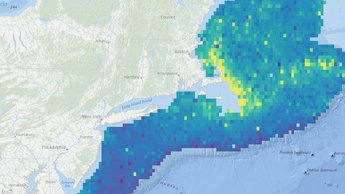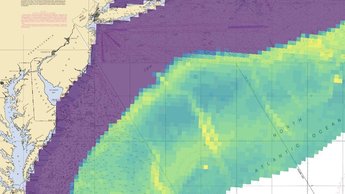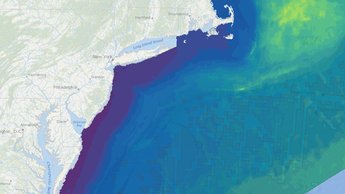Marine Life Data Updated with New Maps, Recent Observations
(Updated 10/1/18)
The Mid-Atlantic Ocean Data Portal, in coordination with the Northeast Data Portal, the Marine Cadastre and the Marine-life Data and Analysis Team (MDAT), announce the release of updated (“Version 2”) marine life data products. Roughly 3,000 maps showing populations and abundance for individual species of fish, birds and mammals along the Atlantic coast comprise the suite of updated marine life data products generated by MDAT to support ocean planning.
What's New
The original Version 1 marine life data products were released in 2016 in two steps – as roughly 100 avian, fish and marine mammal group maps within the Marine Life theme and later 3,000 individual species maps within the Marine Life Library (Species Specific) theme.
The new Version 2 products reflect planned updates to cetacean and bird individual species-level data products by MDAT member groups including the Duke Marine Geospatial Ecology Lab with support from the U.S. Navy, and the NOAA National Centers for Coastal and Ocean Science (NCCOS) with support from the Bureau of Ocean Energy Management (BOEM), respectively. Another MDAT member group, the NOAA Northeast Fisheries Science Center, contributed to updates to fish species group products. Work to develop and present Version 2 MDAT products involved the collaboration and coordination of state and federal agencies, scientific experts, and other ocean planning stakeholders.


Broadly, the updates and changes in Version 2 marine life products include:
- new and recent marine life observations, such as observations from the NOAA Atlantic Marine Assessment Program for Protected Species (AMAPPS);
- new Individual Species products for seven bird species that were not previously included;
- a new Individual Species product for a cetacean species (Cuvier’s beaked whale) that was previously only modeled as part of a guild;
- new Species Group products for fish showing the distribution of some species (Stressor Groups) that are particularly vulnerable to climate change stressors; and
- updates to all other Species Group products (such as Total Abundance, Total Biomass, and Species Richness products for Ecological Groups, Species of Concern Groups, and Stressor Groups) for mammals, birds, and fish using refined calculation methods.
In addition, Version 2 marine life products have a new look and feel, as they are now displayed using color scales that better represent the data, are easier to read by those with visual impairments, and print well in grey-scale.
As with Version 1, Version 2 marine life products have been extensively reviewed by experts in each topic and are accompanied by updated technical documentation and complete metadata which provide citations to relevant peer-reviewed reports and papers. MDAT also updated the technical report that combines information about the methods used to develop the datasets and maps into a single document. Links to the technical report and metadata are provided in the Active tab when viewing the maps on the Portal.
The following documents provide detailed descriptions of updates and changes in Version 2 for each taxa:
- MDAT Cetacean Product Updates Summary of Changes
- MDAT Avian Product Updates Summary of Changes
- MDAT Fish Product Updates Summary of Changes
The new maps can be accessed the same as the previous versions in Marine Planner. A video showing how to use the Marine Life Library (Species Specific) search widget can be found below.

Watch our webinar
The Northeast and Mid-Atlantic Ocean Data Portals offered a joint webinar (posted above) in September 2018 that covered how the data was aggregated and demonstrated how to access and use the maps on the Portals. The session concluded with a Q&A with presenters Jesse Cleary, MDAT/Duke University Marine Geospatial Ecology Lab; Emily Shumchenia, Northeast Ocean Data Portal/MDAT; and Karl Vilacoba, Mid-Atlantic Ocean Data Portal/Monmouth University Urban Coast Institute.
Share this story